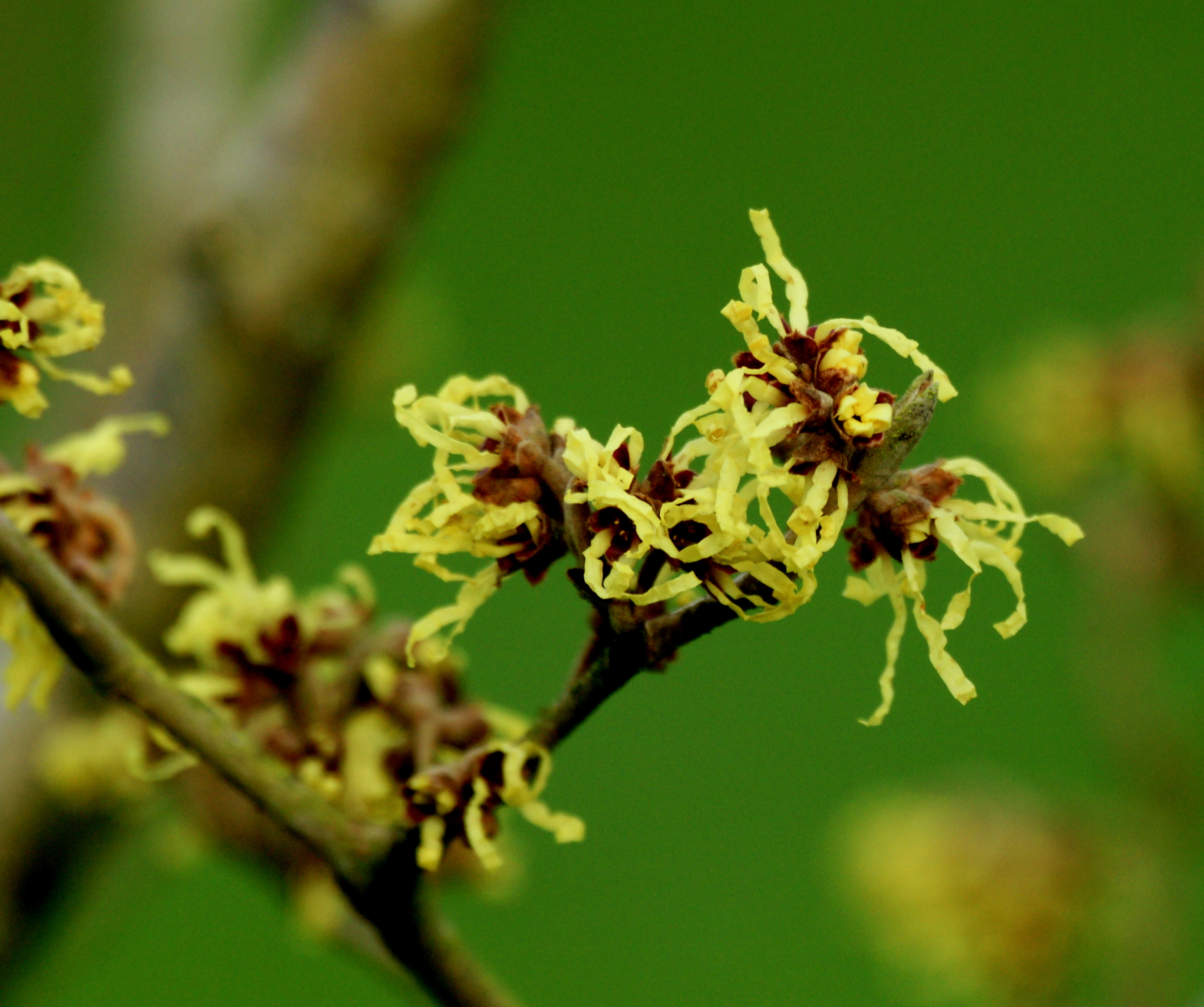Witch Hazel Hamamelis is a deciduous, winter-flowering shrub valued for its profuse, spidery, yellow, orange or red blooms that appear on the bare wood from mid to late winter. They provide welcome colour at this often bleak time of year. In addition, some varieties have a spicy, sweet fragrance and many have excellent autumn leaf colour. They also provide a useful source of early nectar for insects.
Witch Hazel originated in North America, China and Japan. There are three varieties in North America: Hamamelis ovalis, H. vernalis and H. virginiana. Most species bloom from January to March except H. virginiana, which blooms in September to November
American Witch Hazel was introduced to Britain and Europe as a garden plant in 1736. H. mollis was brought from China in 1879 and is the most scented of the winter-flowering Witch Hazels. The cross between H. mollis and the Japanese H. japonica, called Hamamelis x intermedia, has yielded numerous cultivars which range in colour from pale yellow to deep red. Popular examples to grow in the UK include:
Hamamelis x intermedia ‘Pallida’ has sulphur-yellow flowers from December to February and fresh green leaves that turn spectacular shades of yellow, orange and red in the autumn. Height 3m x spread 3m.
Hamamelis x intermedia ‘Jelena’ has copper-orange flowers from January to February and varied autumn colour. Height 4m x spread 4m.
Hamamelis x intermedia ‘Diane’ is a ruby-red, lightly scented variety, flowering from January to February, with excellent autumn colour too. Height 4m x spread 4m.
Origin of name and uses
 The name Hamamelis comes from the Greek for a ‘tree with pear like fruits’ or from Latin, meaning ‘together with fruit’ referring to the simultaneous occurrence of flowers with the maturing fruit from the previous year. When mature, the seed capsules explode apart with a pop, catapulting the two shiny, black seeds up to 10m from the shrub.
The name Hamamelis comes from the Greek for a ‘tree with pear like fruits’ or from Latin, meaning ‘together with fruit’ referring to the simultaneous occurrence of flowers with the maturing fruit from the previous year. When mature, the seed capsules explode apart with a pop, catapulting the two shiny, black seeds up to 10m from the shrub.
Witch Hazel has its origins in mid-16th century English ‘witch’, a variant of early 17th century ‘wych’ used in the names of trees with supple branches (such as Wych Elm) - from Old English wic(e), apparently from a Germanic root meaning 'bend'.
The y-shaped Witch Hazel sticks have been used for dowsing - an ancient method for finding underground water. However, the main use is medicinal as it contains many active compounds. The leaves and bark of the North American H. virginiana may be used in skin treatments, also referred to as Witch Hazel, to remedy cuts, bruises, skin problems and sore eyes. Native Americans used the extract extensively and its use has now become widely established.
How to grow
Witch Hazel likes a neutral to acidic, moderately fertile, moist yet well-drained soil. An open, sunny position is best, although they do tolerate partial shade. Avoid exposed and windy positions. Water plants during dry periods and conserve water by mulching the root area in late winter or early spring. Witch Hazel can be grown in a container in ericaceous compost. Make sure the compost does not dry out, but ensure the pot has good drainage
The shrubs don’t need much pruning if you have room to let them grow to their full size - just cut back any dead wood to healthy young growth and remove any congested, crossing or weak shoots. If you need to restrict the size, then prune after flowering, cutting back each stem to two leaf buds above the spent bloom.
Most Hamamelis cultivars are grafted onto H. virginiana rootstock. In autumn, after leaf fall, remove any shoots from below the line of the graft as these will be from the parent plant.
Insect pollinators
 Witch Hazel is pollinated by various flies and moths in its native habitat. As moths drink the nectar, they accidentally carry pollen between flowers. In the UK flies, bees, butterflies and moths appreciate the early nectar.
Witch Hazel is pollinated by various flies and moths in its native habitat. As moths drink the nectar, they accidentally carry pollen between flowers. In the UK flies, bees, butterflies and moths appreciate the early nectar.
In North America, several species of Eupsilia moths (eg E. morrisoni) feed from the yellow flowers of H. virginiana. We have different species in the UK, for example the Satellite Eupsilia transversa, which is a fairly common moth in much of Britain. The adults emerge in September, and can be encountered any time throughout the winter until April, in suitably mild conditions. Why not check your Witch Hazel after dusk, on dry nights, and let us know if you see any moths nectaring?
Although Scotland, Wales and the north-west of England have just had their wettest December in more than a century, central and southern England escaped the worst of the storms, with rainfall figures much closer to average and mean temperatures topping 9.4C (compared with an average 4.4C for December). Late-winter flowers are a life-saver for insects that are out and about on these unusually warm days, ahead of their normal flight period – currently this includes moths such as the Common Quaker and Hebrew Character. Butterflies such as the Peacock and Red Admiral have also been seen.
If you can’t get out in the garden because of the weather, then why not snip off a few flowering Witch Hazel twigs to bring the lovely smell and colour into your home.
Happy Gardening!
The Secret Gardener


